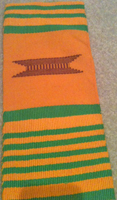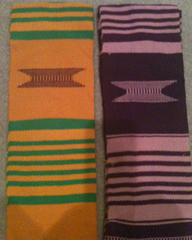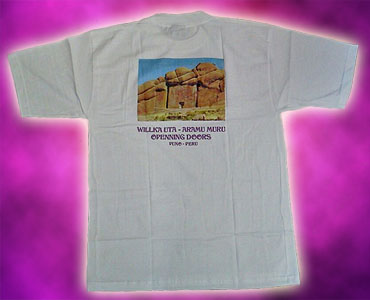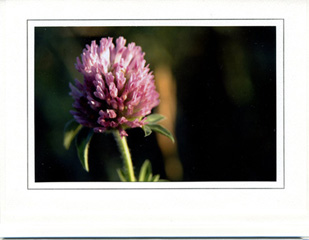Kente Cloth from Our Pilgrimage to Ghana
 Kente cloth, known locally as nwentoma, is a type of cotton fabric made of interwoven cloth strips and is native to the Akan people of Ghana and the Ivory Coast.
Kente cloth, known locally as nwentoma, is a type of cotton fabric made of interwoven cloth strips and is native to the Akan people of Ghana and the Ivory Coast.
Kente cloth has its origin with the Akan people. It is a royal and sacred cloth worn only in times of extreme importance and was the cloth of kings. Over time, the use of kente became more widespread. However, its importance has remained and it is held in high esteem in the Akan family and the entire country of Ghana.
In Ghana, kente is made by the Akan people. It is the best known of all African textiles. Kente comes from the word kenten, which means basket. The Akan peoples refer to kente as nwentoma or woven cloth.
The icon of African cultural heritage around the world, Asante kente is identified by its dazzling, multicolored patterns of bright colors, geometric shapes, and bold designs. Kente characterized by weft designs woven into every available block of plain weave is called adweneasa. The Asante peoples of Ghana choose kente cloths as much for their names as their colors and patterns. Names are derived from several sources, including proverbs, historical events, important chiefs, queen  mothers, and plants.
mothers, and plants.
Meanings of the colors in Kente cloth:
- black—maturation, intensified spiritual energy
- blue—peacefulness, harmony and love
- green—vegetation, planting, harvesting, growth, spiritual renewal
- gold—royalty, wealth, high status, glory, spiritual purity
- grey—healing and cleansing rituals; associated with ash
- maroon—the color of mother earth; associated with healing
- pink—assoc. with the female essence of life; a mild, gentle aspect of red
- purple—assoc. with feminine aspects of life; usually worn by women
- red—political and spiritual moods; bloodshed; sacrificial rites and death.
- silver—serenity, purity, joy; assoc. with the moon
- white—purification, sanctification rites and festive occasions
- yellow—preciousness, royalty, wealth, fertility







